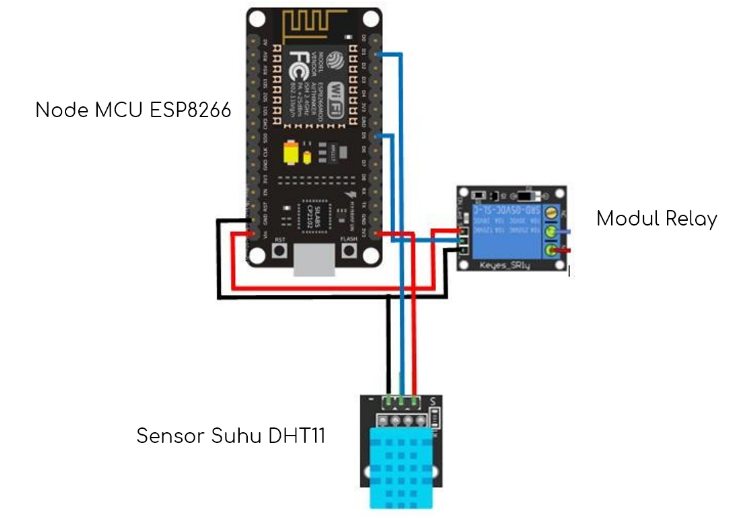IoT-Based Air Conditioner Monitoring and Control at PT XYZ: A Prototype Approach Utilizing Node MCU ESP8266, Relay Modules, and DHT11 Temperature Sensors
Main Article Content
Abstract
This study presents the development and implementation of an IoT-based monitoring and control system for air conditioners (AC) at PT XYZ. Leveraging the capabilities of Node MCU ESP8266, relay modules, and DHT11 temperature sensors, the proposed system enables real-time monitoring of AC status and room temperature. It also facilitates control over individual and multiple AC units, thereby enhancing operational efficiency. The system’s design focuses on energy efficiency, aiming to reduce unnecessary power consumption by ensuring that AC units are active only when needed. The system includes features for monitoring the AC’s on/off status and providing historical temperature data through graphical charts. This real-time data display allows users to track temperature trends and make informed decisions regarding AC operation. The prototype approach employed in this research involves several stages: communication with stakeholders, planning, modeling, prototype development, deployment, and iterative feedback. Testing results indicate that the system effectively meets the research objectives by providing accurate temperature readings and reliable AC control. Compared to existing solutions, this system offers enhanced functionality and integration, contributing to energy savings and improved management of AC units. This research contributes to the field by addressing gaps identified in previous studies and demonstrating the practical application of IoT technology in energy management for air conditioning systems.
Article Details
References
[1] Agung Pradana and Nurfiana. Rancang bangun monitoring dan kontrol suhu ruang server menggunakan perangkat mobile berbasis Internet of Things (IoT). Vol. 4, pp. A93–A98, 2019.
[2] M. Asep Rizkiawan, Harry Ramza, and Agus Sofwan. Internet of Things (IoT) based temperature and humidity detector prototype in the UHAMKA data center room. Indonesian Journal of Artificial Intelligence and Data Mining, 7(4):110–120, 2024.
[3] M. A. Navarrete-Sanchez, Re. Olivera-Reyna, Ro. Olivera-Reyna, R. J. Perez-Chimal, and J. U. Munoz-Minjares. IoT-based classroom temperature monitoring and missing data prediction using Raspberry Pi and ESP32. Journal of Robotics and Control, 6(1):234–245, 2025.
[4] Lara Septiasari and Muhammad Fahriza Firdausy. Sistem kontrol dan monitoring air conditioner berbasis Internet of Things (IoT). Technical Report, 2021.
[5] Fritz Gamaliel and P. Yudi Dwi Arliyanto. Implementasi sistem monitoring dan kontrol air conditioner menggunakan Internet of Things. Jurnal Informatika dan Teknik Elektro Terapan, 11(3):311–318, 2023.
[6] Gohi Diori, Dhea Amelia Rianjani, Gilang Maulana, Tyara Zhafirah Tamzil, Maykel Manawan, and Agus Sukandi. Sistem otomatisasi dan monitoring perawatan berkala AC (Air Conditioner) berbasis Arduino yang terintegrasi IoT (Internet of Things). In Prosiding Seminar Nasional Teknik Mesin, Politeknik Negeri Jakarta, pp. 184–193, 2019.
[7] I. Stoev, S. Zaharieva, and A. Borodzhieva. Internet of Things (IoT) application for temperature control in residential premises. In 21st International Symposium INFOTEH-JAHORINA (INFOTEH), pp. 1–5, East Sarajevo, Bosnia and Herzegovina, 2022.
[8] R. S. Pressman. Software Engineering: A Practitioner’s Approach. McGraw-Hill, New York, 7th ed., 2010.
[9] L. Xu, W. He, and S. Li. Internet of Things in industries: A survey. IEEE Transactions on Industrial Informatics, 10(4):2233–2243, November 2014.
[10] T. Connolly and C. Begg. Database Systems: A Practical Approach to Design, Implementation, and Management. Pearson, Harlow, England, 6th ed., 2015.
[11] S. Bagui and R. Earp. Database Design Using Entity Relationship Diagrams. CRC Press, Boca Raton, FL, 2nd ed., 2011.
[12] M. Fowler. UML Distilled: A Brief Guide to the Standard Object Modeling Language. Addison-Wesley, Boston, MA, 3rd ed., 2004.
[13] NodeMCU Team. Nodemcu documentation. https://nodemcu.readthedocs.io/en/latest/. Accessed: July 2025.
[14] H. Jang. A review of ESP8266 Wi-Fi module based applications. Journal of Embedded Systems, 5(3):45–51, 2018.
[15] Adafruit Learning System. Adafruit DHT11 tutorial. https://learn.adafruit.com/dht. Accessed: July 2025.
[16] DHT11 datasheet. https://components101.com/sites/default/files/component_datasheet/DHT11.pdf. Accessed: July 2025.
[17] Arduino Team. DHT11 documentation on Arduino website. https://www.arduino.cc/en/Reference/DHT11. Accessed: July 2025.
[18] T. Y. Hsu. An overview of DHT11 sensor and its applications in environmental monitoring. Sensors and Actuators B: Chemical, 244:112–120, 2017.
[19] Songle SRD-05VDC-SL-C relay datasheet. https://components101.com/sites/default/files/component_datasheet/SRD-05VDC-SL-C-Datasheet.pdf. Accessed: July 2025.
[20] R. A. Hightower. Relay module: Applications and circuit design. International Journal of Electrical Engineering & Technology, 8(1):78–85, 2016.
[21] W. R. Fenner and R. C. Voth. Fundamentals of Temperature Calibration. John Wiley & Sons, 2005.
[22] J. Smith. Methods for testing IoT systems: A comprehensive review. Journal of Internet Technology, 22(3):123–135, 2022.

